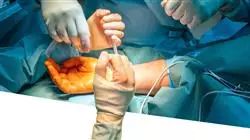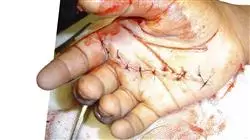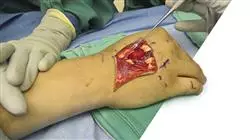University certificate
The world's largest faculty of medicine”
Description
You are in front of the most complete program of clinical knowledge in Hand Surgery. Update yourself with the best specialists in Upper Extremity"

The number of patients requiring surgical interventions in trauma emergencies exceeds 50%, which shows the relevance of this subspecialty in the healthcare field. In addition to this, there is the continuous improvement of technology with the incorporation of Robotics, Artificial Intelligence or 3D, used for the planning of more complex operations.
In this sense, the surgeon is in a moment of transformation and relevance of his performance in order to offer patients effective treatments and to avoid chronic sequelae. A field that requires specialists to be updated in their area. Therefore, in order to promote this update, TECH has designed this 12-month professional master’s degree in Hand Surgery, developed by an extensive faculty of experts in this field.
It is a program that is distinguished by providing the graduate with the most rigorous information, based on the latest medical evidence through high quality teaching materials. In this way, students will delve through video summaries of each topic, videos in detail, complementary readings and simulations of case studies in the most notorious advances in a dynamic and agile way.
From conservative treatments to address fractures and joint dislocations of the fingers and wrist, the possible sequelae, through the management of tendon, nerve and brachial plexus injuries to the latest technical advances will be treated with the utmost rigor in this program. An academic option that also includes specific modules on Dupuytren's disease, Tumors and Vascular Diseases or delves into the Pediatric Upper Limb.
Undoubtedly, an ideal opportunity to take a quality, flexible program that can be completed comfortably, whenever and wherever you want. The student only needs a digital device with an internet connection to view, at any time of the day, the content hosted on the virtual platform. A university proposal that adapts both to the real needs of healthcare professionals and to their most demanding professional activities.
A university program that addresses ultrasound-assisted surgery, which is becoming more and more widespread"
This professional master’s degree in Hand Surgery contains the most complete and up-to-date scientific program on the market. The most important features include:
- The development of practical cases presented by experts in Upper Limb Surgery, Orthopedic Surgery and Traumatology
- The graphic, schematic, and practical contents with which they are created, provide scientific and practical information on the disciplines that are essential for professional practice
- Practical exercises where self-assessment can be used to improve learning
- Its special emphasis on innovative methodologies
- Theoretical lessons, questions to the expert, debate forums on controversial topics, and individual reflection assignments
- Content that is accessible from any fixed or portable device with an Internet connection
Delves into specific wrist and hand injuries in certain work and physical activities such as those produced in climbers"
The program’s teaching staff includes professionals from the field who contribute their work experience to this educational program, as well as renowned specialists from leading societies and prestigious universities.
The multimedia content, developed with the latest educational technology, will provide the professional with situated and contextual learning, i.e., a simulated environment that will provide immersive education programmed to learn in real situations.
This program is designed around Problem-Based Learning, whereby the professional must try to solve the different professional practice situations that arise during the academic year This will be done with the help of an innovative system of interactive videos made by renowned experts.
A program designed to fit your professional agenda and your most demanding responsibilities"

Get an update on the great impact of Robotics or 3D printing in Hand Surgery"
Objectives
This university program offers surgeons a complete update on the various hand pathologies, their sequelae and the most effective treatments currently available. An academic itinerary that facilitates an update thanks to the innovative teaching tools provided by TECH and an excellent team of specialists dedicated to this field and with continued clinical experience in hospitals of national and international reference. A unique opportunity offered only by this institution, the largest digital university in the world.

You will be up-to-date in the planning of the most advanced treatments in Hand Surgery in only 12 months"
General Objectives
- Update knowledge in the different medical and basic specialties surrounding hand pathology
- Determine the types of wound healing, sutures and skin grafts to specify the treatment of less complex wounds; escalating to the management of complex wounds
- Analyze the basic anatomy of the wrist and hand to provide a starting point from which to recognize injuries that may occur after trauma or injury of any kind
- Structure the bony and ligamentous anatomy of metacarpals and phalanges of the hand
- Analyze different surgical approaches to the hand
- Compile current arthroscopic treatment methods
- Establish general criteria for the anatomy and pathophysiology of osteoarthritis in the various joints of the wrist and hand
- Analyze in detail the anatomy of the flexor and extensor tendons of the hand, as well as the detailed development of their vascularization and the biology of tendon healing
- Homogenize knowledge and skills in the pathology of the peripheral nerve of the upper limb and brachial plexus
- Update diagnostic and therapeutic knowledge based on the fundamental principles of nerve and brachial plexus injuries
- Guide the different therapeutic options (conservative and surgical) as well as the appropriate time to perform them
- Examine the different surgical techniques used in the treatment of the different pathologies of the pediatric upper limb
- Delve into the anatomical and pathophysiological knowledge of Dupuytren's disease through physical examination and accurate use of the classification of the disease, to determine the appropriate timing of surgical treatment
- Analyze the surgical techniques available in primary and relapsed Dupuytren's disease and the sequelae of previous treatments
- Show the advantages of ultrasound for daily practice in Traumatology
- Explore occupational hand-wrist injuries
- Develop the latest technological advances in Hand Surgery
Specific Objectives
Module 1. Basic sciences applied to hand and upper extremity surgery. Methodology. Rehabilitation
- Place chronologically the current state of hand surgery after a historical review
- Analyze the physiological bases necessary for the study of hand pathology
- Define the imaging techniques available for the study of hand pathology, develop each of them and specify their indications
- Review the anesthetic techniques used during hand surgery
- Delve into the advantages, disadvantages and risks of each of them and understand the indication of one or the other
- Delve into orthopedic and rehabilitative treatment in hand pathology processes, as well as non-surgical treatments, and their importance in the postoperative period
- Develop the concepts of hand surgery research, analyzing the different types of clinical studies and levels of scientific evidence
Module 2. Hand Skin, Soft Parts and Infections
- Examine types of hand wounds, wound healing and types of sutures
- Delve into the knowledge of skin grafts
- Analyze the use of microsurgery for skin coverage in the Hand, as well as for reimplantation
- Analyze infections of the hand, cellulitis, tenosynovitis, arthritis and osteomyelitis
- Determine detailed management of the burned hand and its consequences
Module 3. Fractures and joint dislocations Wrist-Hand. Conservative and Surgical Treatment. Sequels
- Delve into the types of distal radius and ulna fractures, as well as specify a specific diagnostic method and treatment protocol for each injury
- Develop the criteria for distal radioulnar instability in order to establish a correct method of diagnosis and treatment
- Analyze the anatomy and vascularization of the scaphoid, as well as evaluate fracture patterns and how they affect the evolution of the fracture
- Identify the different scaphoid fracture patterns that will determine the possible complications that may occur
- Introduce the complications associated with the non-treatment of distal radius fractures, scaphoid or carpal dislocations, as well as their diagnosis and definitive treatment
Module 4. Finger Fractures and Dislocations Conservative and surgical treatment. Sequelae. Wrist Arthroscopy
- Structure injury mechanisms and types of fractures of phalanges and metacarpals
- Expose periungual injuries and their most effective treatment according to the type of involvement
- Classify specific ligamentous injuries of the fingers and their most specific treatment
- Examine the most commonly used arthroscopic portals
- Establish arthroscopic evaluation pathway to diagnose possible injuries
Module 5. Inflammatory Arthritis and Degenerative Arthrosis of the Wrist and Hand. Conservative and Surgical Treatment. Evidence
- Define the basic differential diagnosis of wrist and hand arthropathies
- Obtain a global vision of the Inflammatory Arthropathies to see the differences between them and also to discern the best treatment for each one of them
- Analyze rhizarthrosis, its diagnosis and severity classification and develop the different therapeutic strategies, conservative or surgical
- Identify osteoarthritis of proximal and distal interphalangeal joints, carpometacarpal joints (excluding the thumb, mentioned in another topic) and scapho-trapezio-trapezoid joints
- Develop the known surgical techniques and master their indications and technical details
- Present the degenerative pathology of the triangular fibrocartilage as an important triggering factor of wrist discomfort
- Clarify the pathophysiology of Kienböck's disease, the Gold standard for its diagnosis and be able to classify it in severity, thus being able to choose the best treatment
Module 6. Tendon Injuries of the Hand
- Examine in detail the anatomy and vascularization of the flexor and extensor tendons and analyze their biomechanics
- Delve into the diagnosis and prognosis of flexor tenosynovitis of the fingers, as well as its complications
- Evaluate extensor tenosynovitis from its initial diagnosis to its conservative and surgical treatment
- Examine the different tendon suturing techniques in different flexor tendon areas, as well as types of post-surgical immobilization and initiation of rehabilitative therapy
- Identify extensor tendon rupture zones and their optimal treatment, as well as their rehabilitation protocol
- Delve into the complications of extensor tendon sutures and their treatment
- Analyze flexor suture failures and their treatment
Module 7. Nerve and Brachial Plexus Injuries
- Develop the embryology and anatomy of the brachial plexus and distal branching to the peripheral nerves of the upper limb
- Establish the etiology and pathophysiology of compressive syndromes of the ulnar, median and radial nerves
- Identify other compressive factors in wrist and hand or other pathologies, such as thoracic gorge
- Examine the principles, indications and surgical recommendations for nerve repair and nerve transfer techniques
- Demonstrate palliative tendon surgery as a valid option for the treatment of peripheral nerve palsy after failure of other nerve rescue techniques
- Fundamentals of basic principles of strategy and management of brachial plexus pathology
- Define central nervous system lesions, analyze signs and symptoms of spasticity and generate surgical strategies for tetraplegia
Module 8. Pediatric Upper Member
- Delve into the knowledge of the origin and embryology of the different congenital malformations
- Identify the different congenital malformations, studying, in each pathology, its etiopathogenesis, clinical study, complementary studies, classifications and treatments
- Evaluate the different treatment options for tumors affecting the pediatric hand, including resections, amputations and reconstructions in the surgical treatment
- Evaluate and analyze the treatment options for obstetric brachial plexus injuries, including conservative and surgical treatment
Module 9. Dupuytren's Disease, Tumors and Vascular Diseases
- Delve into the surgical anatomical knowledge of the palmar fascia
- Delve into the pathophysiological stages of Dupuytren's disease and the clinical classification of the disease
- Examine the different techniques for the treatment of Dupuytren's disease, both with collagenase (not available in Europe) and by selective regional fasciectomy
- Evaluate surgical incisions for primary surgery, complications and sequelae in Dupuytren's disease
- Develop vascular pathology in the hand, both tumors and malformations, as well as Raynaud's disease and hypothenar hammer syndrome
- Analyze soft tissue and bone tumors of the hand and establish the best diagnostic techniques
- Delve into the surgical treatment techniques adapted to the most common tumors, taking into account their prognosis of recurrence
Module 10. Advances in Hand Surgery. Other Lesions
- Provide step-by-step guidelines for the diagnosis and ultrasound-guided treatment of hand and wrist injuries
- Evaluate hand injury prevention and treatment guidelines for climbers and musicians
- Identify patients most susceptible to occupational hand injuries
- Establish treatment protocol for CRPS

You will be aware of the scientific evidence for the choice of conservative or surgical treatments in inflammatory arthritis"
Professional Master's Degree in Hand Surgery
Hand surgery is a medical specialty that deals with the diagnosis, treatment and rehabilitation of injuries and disorders affecting the hand and wrist. Currently, there is a growing demand for highly trained professionals in this area, due to the increase in injuries and diseases related to the excessive use of electronic devices and the practice of high-impact sports. In our institution's Professional Master's Degree in Hand Surgery, we offer comprehensive and specialized training for those physicians interested in acquiring the knowledge and skills necessary to effectively treat hand and wrist problems. During the program, participants will learn the most advanced diagnostic techniques, the latest trends in reconstructive surgery and the most efficient rehabilitation protocols for optimal patient recovery.
Our Professional Master's Degree in Hand Surgery focuses on providing participants with a cutting-edge education, combining theory and practice to ensure a comprehensive and quality training. Students will have the opportunity to work alongside experienced professionals in specialized clinics and hospitals, allowing them to gain hands-on experience and develop the skills necessary to meet the challenges that arise in the field of hand surgery. In addition, the program will address key topics such as microvascular surgery, wrist arthroscopy, treatment of complex fractures and functional rehabilitation of the hand. Upon completion of the Professional Master's Degree, participants will be prepared to provide comprehensive care to patients with hand and wrist pathologies, thus improving their quality of life and overall well-being.







